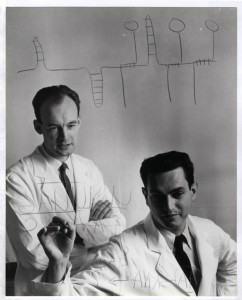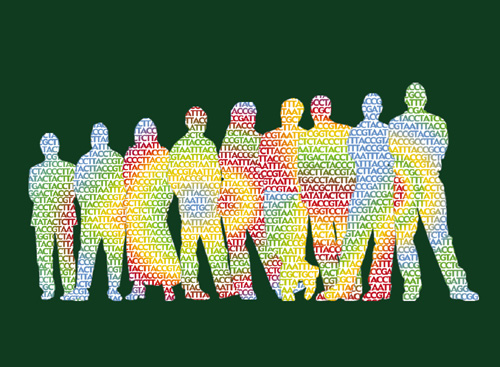1960′s lab life with the Nobel Prize-winning decipherer of the genetic code

Norma Zabriskie Heaton, Marshall Warren Nirenberg, and Theresa Caryk, ~1964. Photo courtesy of Norma Zabriskie Heaton.
Note: Dr. Marshall Warren Nirenberg received the Nobel Prize in Physiology or Medicine in 1968 for deciphering the genetic code. He was born in New York City on April 10, 1927, and died January 15th, 2010. Marshall spent over 50 years working at the National Institutes of Health (NIH). At a memorial service at NIH in his honor on October 8, 2010, friends and colleagues gathered to paid tribute to this titan of science. One of the speakers was Norma Zabriskie Heaton. She is shown above on the left, with a slide rule and lab notebook in her hands. Following are highlights of her tribute.
Guest post by Norma Zabriskie Heaton.
I was one of Marshall’s technicians, along with Theresa Caryk and Linda Greenhouse, when the genetic code was cracked and deciphered, and I continued to work for him for almost 40 years.
When Marshall interviewed me for the job in 1963 he told me he had an idea that would involve working with cockroach legs. I didn’t like bugs, but I took the job anyway and am glad I did. (We never did use cockroach legs.)
I would like to take you back to those early days and share with you what it was like working in the lab when the genetic code was deciphered. The lab work was intensive, exciting, and downright fun. But it could also be frustrating, stressful and tedious.
How many people have the opportunity to work on a project that is so significant and fulfilling? The challenge sometimes was to see beyond the repetition to the goal. Sometimes I thought that if I had to do one more binding assay protocol I’d scream. But the repetition was just Marshall’s obsession with accuracy and reproducibility.
Marshall was modest, soft-spoken and kind. He was a true gentleman and it was his nature to be generous with praise. He was very creative and had so many ideas – he liked to try them out with fast little experiments just to see where they might lead – he called them “quickies.”
Marshall was very focused and demanding. He had a meticulous and painstaking approach to data analysis and when you discussed your results with him, he expected you to know your experiments inside and out, backward and forward. No detail was overlooked or insignificant to him, and you had better know which solutions you used, who made them, when they were made, how they were made and the lot number of every reagent.
Marshall didn’t keep the same hours as the rest of the lab. He might arrive anywhere from mid-morning to early-afternoon and he would always work very late into the night. “How goes it?” was a typical greeting.
He wrote out the protocols to follow and left them on the lab bench. His handwriting could be challenging to decipher, but, like learning a foreign language, it became easier with time. He told me it was because he was a natural lefty, forced to learn to write with his right hand.
The labs were all crowded – we didn’t work side by side – it was elbow to elbow. It was so busy that Theresa labeled our TCA reagent in Ukrainian so that it didn’t wander off. Marshall had a tiny office in the back part of our single module lab just wide enough for his desk, two chairs and a file cabinet, and you usually had to clear off a chair in order to sit down.

Heinrich Matthaei and Marshall Nirenberg, 1962. Photo courtesy of Profiles in Science, National Library of Medicine.
Marshall and Phil Leder devised what became known as the binding assay. This was the assay that we went on to use to decipher the 64 triplets of the genetic code. Marshall was always pleased when we could end the week with a successful experiment, so when I ran the first binding assay just before the Thanksgiving holiday in 1963, it was a high note.
I will never forget hearing the shouts, especially from Ed Scolnick and Mert Bernfield, when the latest codon result would come off the Nuclear Chicago planchet counter tucked into a tiny alcove in the hallway. Marshall was always just as delighted but his reaction was more restrained – he might pump his fist and say “wonderful.”
Some of you will recall that back in the olden days, there were no calculators so we used slide rules to get our results. This was before the days of personal computers and spreadsheets so tabulating a summary of our results as each triplet codon was deciphered was challenging. I taped enough data paper together to create very large charts and drew the columns and rows with a ruler. Then, I painstakingly entered all the data from our experiments by hand. The resulting charts would become the “Rosetta Stone of the Genetic Code” and some of them are now in the Smithsonian and the Library of Medicine.
Manuscripts were written and rewritten, typed and retyped ……. often up until the last moment before the deadline. This was before the days of e-mail and fax machines, so when Marshall and the secretary finished his paper for the Lasker Foundation award at 3 a.m. the morning of its deadline, Marshall left me a plane ticket and I flew to New York and hand delivered his paper to the Lasker Foundation headquarters. The very next morning was Wednesday October 16th, 1968 and it was announced that Marshall had won the Nobel Prize.
Marshall had many interests, and one of them was archeology. He told me he had even once considered it as a field of study for himself. So I asked him, if he had the opportunity to go back in time to see and relive the past or to go forward in time to see into the future, which would he choose? And, without hesitation, he said he would want to go forward.

Marshall Nirenberg with test tubes, 1990s. Photo courtesy of Profiles in Science, National Library of Medicine.
By the time Marshall had won the Nobel Prize he was already looking forward to studying the brain and the nervous system.
Marshall had an inquisitive mind, the capability to ask the important scientific questions, and the discipline to seek the answers. He set high standards and recognized that ethical responsibility must go hand in hand with scientific discovery.
He knew that knowledge was what would last and endure for all eternity and that the knowledge we amassed was a legacy that would live on.
He emphasized to me that I should always be proud of my contribution to this knowledge.
I will always treasure the memory of this extraordinary man and I am so grateful I had the opportunity to know and work with him.
Norma Zabriskie Heaton is now retired and spends her days obsessed with genealogy. She and her husband live with their 2 dogs and cat in an old stone farmhouse which she and her husband have restored. She also enjoys gardening, needlework, reading and listening to music on her iPod.
Learn more about Dr. Marshall Nirenberg and his research
- The Marshall W. Nirenberg Papers, Profiles in Science, The National Library of Medicine, NIH
- Marshall Nirenberg: Deciphering the Genetic Code, Office of NIH History, NIH
- The Nobel Prize in Physiology or Medicine 1968, The Nobel Foundation
- 2010 NIH Symposium in Neurobiology-A Tribute to Marshall W. Nirenberg (videocast)
- Marshall Nirenberg Memorial Service (videocast)
Marshall Nirenberg was laboratory chief of the Laboratory of Biochemical Genetics at the National Heart, Lung, and Blood Institute, part of the NIH. I had the honor of training in the lab and would like to thank Norma Zabriskie Heaton and other members of the laboratory for their friendship, intellectual curiosity, and support over the years.











Trackbacks & Pingbacks
[…] 1960′s lab life with the Nobel Prize-winning decipherer of the genetic code […]
Leave a Reply
Want to join the discussion?Feel free to contribute!